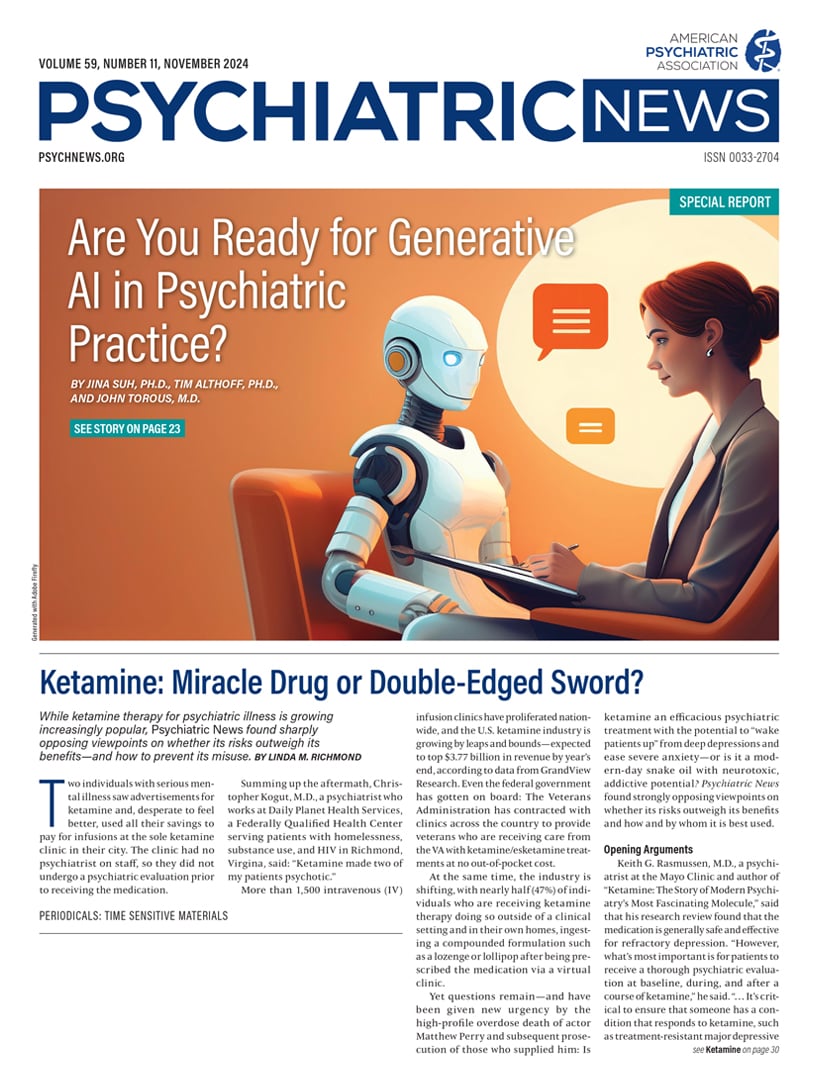Psychiatric advance directives (PADs), currently allowed by law in 25 states, provide an opportunity for patients to outline their preferences about their mental health treatment should they become unable to make such decisions for themselves in the future. Yet one element of well-being has been left out of PADs: reproductive care.
To address this, a workgroup of experts in California came together to create a template that people who may become pregnant can use to document their decisions about medical and psychiatric care should they not be able to make those decisions during pregnancy, labor, delivery, or the postpartum period. The workgroup’s efforts are built on a framework of reproductive justice based on three key rights:
•
Everyone has the right to have a child.
•
Everyone has the right not to have a child.
•
Everyone has the right to raise a child in a safe, healthy environment.
“The right to bear a child has been infringed upon for a lot of people,” said Emily C. Dossett, M.D., lead author of a
paper in the
Archives of Women’s Mental Health that describes the workgroup’s efforts. Dossett is the medical director of the PROMISE Perinatal Psychiatry Access Line in the Los Angeles County Department of Mental Health Services. “We assume that people with serious mental illness cannot bear or raise children. We want to be sure we’re clear about giving women the power to do that, and the power of what to do when they conceive.”
Coauthor Keris Jän Myrick, M.B.A., M.S., a certified personal medicine coach in Los Angeles, can attest to the need to protect the reproductive health and decisions of patients with serious mental illness. When she was diagnosed with schizophrenia, there was no discussion of her goals for a family or how her treatment might affect her fertility.
“Nobody asked me if I wanted to have kids. They just gave me medications that affected my ability to have them,” she said. “They basically said, ‘Who cares? It’s not important.’ But I wanted to be a mom of a ridiculously large amount of children.”
Myrick, who is Black, said there were likely multiple forms of discrimination against her, and that such discrimination still occurs. “There was a type of ‘saneism’ in this, where they were thinking I may get sick, so I might not be able to care for children,” she said.
“But with me, there was a level of complexity in that I am African American. On the provider’s side, there can be racism in decisions like that,” Myrick said. “It’s not as if this doesn’t happen in 2024, so [reproductive PADs] are a way for us to state what we want.”
Creating Space for Reproductive Health
As a psychiatrist specializing in women’s health, Dossett has always felt that reproductive health care should be part of mental health care. “As psychiatrists, we see these patients before they become pregnant, while they’re pregnant, and after they’re pregnant. We often see them more than their primary care doctors,” she said. “If our patients want to become pregnant, we should help them plan for that.”
To that end, one section of the workgroup’s reproductive PAD focuses on psychiatric care in pregnancy, including a discussion of medication. “One of the issues we encounter is a concern that any medication patients take can be harmful for the baby, and patients either stop taking the medications themselves or stop taking it on the advice of a health provider who has the same perception,” said coauthor Michelle T. Nguyen, M.D., a maternal-fetal medicine physician at Specialty Obstetrics of San Diego.
“But we know that inadequately treated mental health issues lead to worse outcomes for both the mother and the baby,” Nguyen said. “This goes beyond relapse of the mother’s mental illness, and includes increased risk of preterm birth, low birth weight, and missed prenatal care appointments.”
Dossett agreed, noting that in most cases, the evidence does not support taking pregnant people off psychiatric medications. “The risk of taking medications is largely far less than the risks of not taking the medications,” she said. “Think of the risk of a patient having psychosis or becoming manic while pregnant and the stress that puts on the fetus. Then there is detrimental behavior like smoking or substance use.”
Dossett and Nguyen noted that valproic acid and carbamazepine should not be used in pregnant people because they increase the risk of developmental delays and birth defects in the child. In addition, lithium should be tightly monitored, although it can be used if necessary.
“Recent data show that although taking lithium during pregnancy increases the risk of cardiac birth defects, the absolute risk is less than 1%,” Dossett said. “If it works for a woman and you have her stop taking it, her risk of becoming bipolar, manic, or depressed is higher than 70%.”
Preparing for Future Care
In addition to accounting for psychiatric care during the patient’s pregnancy, the workgroup’s template covers patients’ health and pregnancy history and lists opportunities for them to describe their wishes concerning labor and delivery. These include decisions about potentially life-saving procedures such as induction, C-section, vacuum- or forceps-assisted delivery, blood transfusion, and anesthesia and pain control for labor and the postpartum period.
Nguyen said that documenting patients’ wishes regarding these aspects of pregnancy, labor, and delivery in a reproductive PAD can help other health professionals who encounter the patient. She recalled a patient in labor whose conservator had signed a consent form on the patient’s behalf for treating both patient and baby. However, the form did not specifically state which procedures were included, with the result that nurses were reluctant to give the patient an epidural because they did not see it in the document.
“There is a kind of moral distress for providers in these situations,” Nguyen added. “They don’t want to cause harm, and they don’t want to do any procedures or surgery if the patient wouldn’t consent to it, but they also want to protect the health of the pregnant woman and fetus.”
In another case, a psychiatrist had kept a pregnant patient on the lowest dose of haloperidol throughout the pregnancy because he was worried about harm to the baby. Because of the severity of her psychosis, the patient stated that she did not have a cervix and she refused cervical exams. Even when she acknowledged her pregnancy, she stated that her baby would teleport out of her body.
“We needed a plan of what to do if she went into labor. We tried to seek advice from both the ethics team and the legal team, who deferred to each other,” Nguyen said. “This case [not only] highlighted missed opportunities for interdisciplinary care and the importance of communication between various members of the health care team, it also highlighted the importance of trying to make decisions and plans for health care in advance of an obstetric emergency or psychiatric crisis.”
The template also covers contraception (e.g., whether the patient wishes to have an IUD inserted after labor), breastfeeding, and custody of the child should something happen to the mother and there is no other legal custodian of the child such as the father or a partner. However, the template addresses abortion only as something for patients to think about and discuss with their agents or health supporters.
Dossett explained that the workgroup started designing the template before the U.S. Supreme Court’s decision in Dobbs v. Jackson Women’s Health Organization.
“We did it in part because we wanted to include discussion of pregnancy termination, but by law you have to be competent and have the capacity to make the decision to terminate a pregnancy in the moment, at the time of the procedure,” she said.
Therefore, the template notes that by law, health care agents or supporters cannot give permission for patients to have an abortion, even if a patient says in a PAD that they would want them to. The decision must come directly from the patient.
Starting the Conversation
Myrick said that the best way to talk to patients about their reproductive plans is to ask questions. “Ask them if being a parent is a goal of theirs, and then explore that,” she said. “Ask them what it means to them and how they hope for it to happen. Think about how it can be part of caring for the whole person, and meeting and honoring their needs.”
Nguyen agreed, adding that the conversation should unfold into a discussion of either contraceptive options or preconception counseling. “If they don’t want to get pregnant, they may wonder why they need to worry about it,” Nguyen said. “But you can explain that sometimes pregnancies are unplanned, and you want to be prepared to take care of your patient and the baby according to the patient’s wishes.”
Preconception counseling should include a discussion of risks. “You can have a discussion where you can point out that sometimes in pregnancy mental health may worsen, and the patient may not be able to make decisions for themselves,” Nguyen said.
Dossett said that all conversations should begin from a place of cultural humility. “There are so many cultural backgrounds that there is no way we could have an algorithm for that,” she said. “But as long as there is openness and respect, and you’re not making any assumptions, you can have a [productive] discussion.”
This work was supported by the California Health Care Foundation. ■




